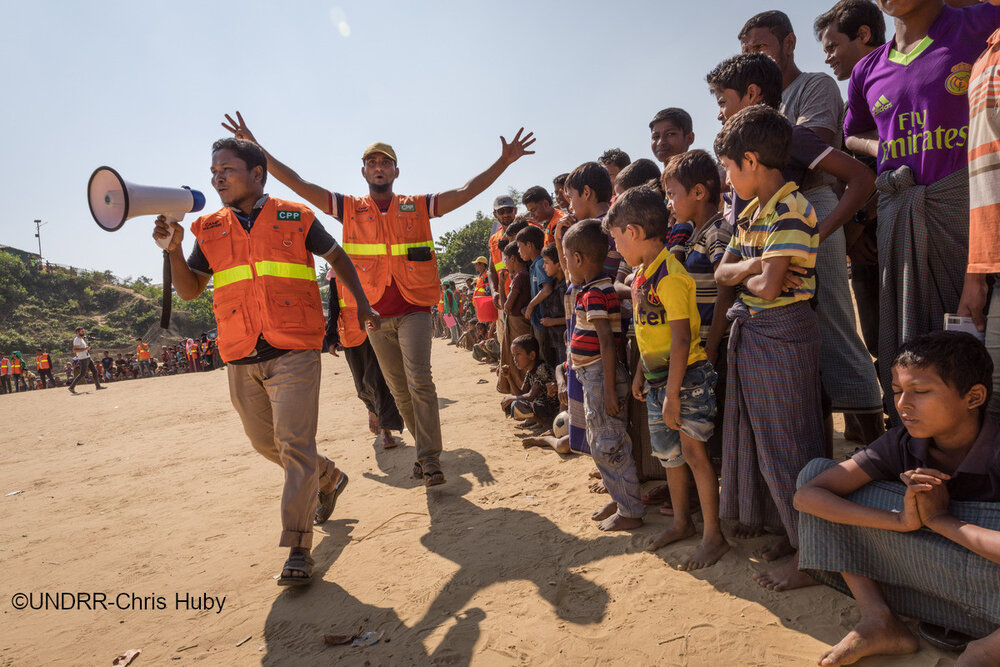Earth observations for early warning for all

Today’s International Day for Disaster Risk Reduction (DRR) focuses on the value of investing in early warning and early action for all.
Early warning saves lives and reduces damage and costs. Just 24 hours warning of a coming storm or heatwave can cut the ensuing damage by 30 per cent and spending US$ 800 million on such systems in developing countries would avoid losses of up to $16 billion per year, according to a 2019 report.
However, a report launched by the UN Office of Disaster Risk Reductions (UNDRR) and the World Meteorological Organization (WMO) today uses the most recent data to find that half of the countries globally are not protected by multi-hazard early warning systems (MHEWS).
The report, Global Status of Multi-Hazard Early Warning Systems - Target G, further highlights gaps in different elements of early warning systems. For instance, little over half of the countries with MHEWS confirmed access to observations and forecasting, a critical element of early warnings. This becomes further challenging given the changing nature of hazards. The report highlights that only 42 per cent of WMO Members had availability of monitoring and forecasting for multiple hazards occurring simultaneously or cumulatively over time.
Earth observations (EO) and the GEO community can play a unique role in early warning, as well as the broader and increasingly complex landscape of cascading and systemic risks. The 2022 edition of the UN Global Assessment Report on Disaster Risk Reduction 2022 (GAR 2022), a flagship report developed by UNDRR provides guidance on the role of EO and points to the need for an integrated approach to risk.
As stated in the GAR 2022 report, COVID-19 and climate change are rapidly making it clear that, in today’s crowded and interconnected world, disaster impacts increasingly cascade across geographies and sectors. Despite progress, risk creation is outstripping risk reduction. Disasters, economic loss, and the underlying vulnerabilities that drive risk, such as poverty and inequality, are increasing just as ecosystems and biospheres are at risk of collapse. Global systems are becoming more connected and therefore more vulnerable in an uncertain risk landscape.
The GAR 2022 report emphasizes the importance of governance approaches that consider “complex causal structures, dynamic evolutions and cascading or compound impacts.” It calls for “transformations in what governance systems value and how systemic risk is understood and addressed.”
In this context of addressing systemic risks, GAR 2022 talks about the usefulness of EO in all disaster phases. It points out how EO is being used for:
- improving the understanding of long-term changes in climate and impact on people,
- seasonal weather forecasts,
- early warning of hazardous events, and
- ongoing international efforts to provide close to real-time impact assessment on disasters.
In other words, EO plays an important role in highlighting the full direct and indirect impacts of disasters, as well as pointing to areas of risk, by putting a special focus on most vulnerable populations and exposed assets, especially when working in collaboration with disaster management agencies, climate change adaptation and development actors.
In keeping with the theme of today’s International Day for DRR, EO can play a crucial role in achieving Target G of the Sendai Framework: “Substantially increase the availability of and access to multi-hazard early warning systems and disaster risk information and assessments to people by 2030.” This is because Earth observations provide insights and supporting information for hazard monitoring, forecasting and prediction as well as disaster risk assessment, all of which needs to be integrated to formulate an early warning system.
The GAR 2022 report highlights efforts by the Group on Earth Observations to support DRR, for example, with the crop monitoring early warning system (CM4EW) via GEO’s Global Agricultural Monitoring (GEOGLAM) programme. The report also suggests the potential contribution of EO to improve public health through ongoing GEO efforts in wildfire monitoring (through the Global Wildfire Information System: GWIS) and newer air quality/pollution monitoring research (through Geodesy for the Sendai Framework: GEODESY4SENDAI), which can contribute to early warning systems.
Considering the GAR 2022 recommendation for collaboration across disciplines, creating a common ‘risk language’ that can cut across all sectors, the GEO community is coming together to discuss how EO data can best provide risk information and assessment on reducing systemic risk and disaster impacts to multiple fronts of governance systems, such as civil defense, health, energy, food, and environment. The planned Coordination Workshops on integrated themes, including on EO for Systemic Risks with an emphasis on multi-hazard early warning systems will be an important step towards that goal. The upcoming GEO Week 2022, including the side events by the GEO DRR Working Group and Health Community of Practice will deepen the conversation across and beyond the GEO community.
More details on EO contributions to DRR are available in three GAR2022 contributing papers, submitted by several authors of this blog post: